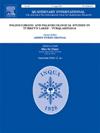Indian summer monsoon variations since late MIS3: A perspective from multiproxy evidence from Lake Xingyun in southwestern China
IF 1.9
3区 地球科学
Q3 GEOGRAPHY, PHYSICAL
引用次数: 0
Abstract
The variability of the Indian summer monsoon (ISM) is a central research topic tightly linked to precipitation changes in the highly populated South Asian monsoon region. Understanding the variability and related dynamic mechanisms of the ISM on orbital-millennial time scale provides insight into the metastable nature of the Earth's system, which offers favorable conditions for disaster prevention and mitigation. Here, we present a multiproxy record spanning the late Marine Isotope Stage 3 (40.2–0.0 cal ka BP), including median grain size, n-alkane distribution pattern, hydrogen isotope of C31 n-alkane (δDC31), and stable oxygen isotope of endogenic carbonates (δ18Ocarb) from Lake Xingyun in southwestern China. The results showed that the ISM relatively strong during 40.2–30.0 cal ka BP, weakened during 30.0–16.0 cal ka BP and then it was progressively enhanced during 16.0–11.7 cal ka BP. The strongest ISM occurred during 10.7–6.5 cal ka BP and became weakened during 6.5–0.0 cal ka BP. The ISM precipitation increased overall with rising temperatures on the orbital scale despite of some millennial exceptions. The ISM variations were strongly controlled by changes in Northern Hemisphere summer insolation, and influenced by Earth's boundary conditions (i.e., CO2 concentration and ice sheets) during the glacial-interglacial period. Moreover, the Heinrich Events (i.e., H3, H2, and H1) and Younger Dryas (YD) occurred in different climatic states of the Earth system, and thus the ISM responded differently in magnitude to these millennial-scale cold events. As such, the ISM during Heinrich Events (i.e., H3, H2, and H1) was more significantly weakened than that during the YD. These findings highlight the complexity of ISM changes with different warming scenarios, and provide a perspective for understanding the different hydrological responses to abrupt cold events in terms of magnitude.
MIS3晚期以来的印度夏季风变化:来自中国西南星云湖多代理证据的视角
在人口密集的南亚季风区,印度夏季风的变率是一个与降水变化密切相关的中心研究课题。了解ISM在轨道-千年时间尺度上的变率及其相关动力机制,有助于深入了解地球系统的亚稳态特性,为防灾减灾提供有利条件。在此基础上,研究了中国西南星云湖晚海相同位素第3阶段(40.2 ~ 0.0 cal ka BP)的中位粒度、正构烷烃分布模式、C31正构烷烃氢同位素(δDC31)和内源碳酸盐岩稳定氧同位素(δ18Ocarb)的多代记录。结果表明,ISM在40.2 ~ 30.0 cal ka BP期间相对较强,在30.0 ~ 16.0 cal ka BP期间减弱,在16.0 ~ 11.7 cal ka BP期间逐渐增强。ISM在10.7 ~ 6.5 cal ka BP最强,在6.5 ~ 0.0 cal ka BP减弱。在轨道尺度上,ISM降水总体上随着温度的升高而增加,尽管有一些千年的例外。在冰期-间冰期,ISM的变化受到北半球夏季日照变化的强烈控制,并受到地球边界条件(即CO2浓度和冰盖)的影响。此外,海因里希事件(即H3、H2和H1)和新仙女木事件(YD)发生在地球系统的不同气候状态,因此ISM对这些千年尺度冷事件的响应幅度不同。因此,海因里希事件(即H3、H2和H1)期间的ISM比YD期间的ISM减弱更明显。这些发现突出了不同变暖情景下ISM变化的复杂性,并为从量级上理解突变冷事件的不同水文响应提供了一个视角。
本文章由计算机程序翻译,如有差异,请以英文原文为准。
求助全文
约1分钟内获得全文
求助全文
来源期刊

Quaternary International
地学-地球科学综合
CiteScore
5.60
自引率
4.50%
发文量
336
审稿时长
3 months
期刊介绍:
Quaternary International is the official journal of the International Union for Quaternary Research. The objectives are to publish a high quality scientific journal under the auspices of the premier Quaternary association that reflects the interdisciplinary nature of INQUA and records recent advances in Quaternary science that appeal to a wide audience.
This series will encompass all the full spectrum of the physical and natural sciences that are commonly employed in solving Quaternary problems. The policy is to publish peer refereed collected research papers from symposia, workshops and meetings sponsored by INQUA. In addition, other organizations may request publication of their collected works pertaining to the Quaternary.
 求助内容:
求助内容: 应助结果提醒方式:
应助结果提醒方式:


